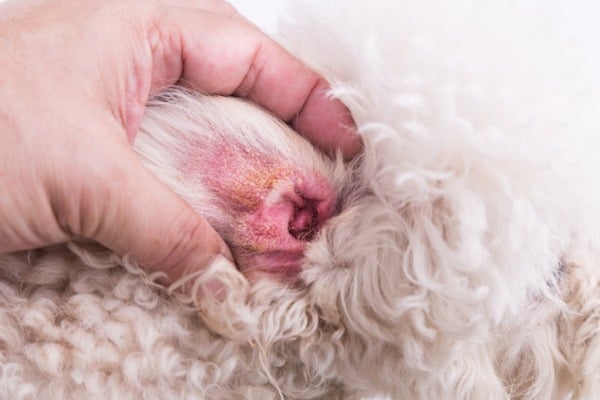
As pet owners, we spend a lot of time petting, playing with, and cuddling our dogs, becoming familiar with what’s normal and unusual about their bodies. This includes their temperature. When a dog feels abnormally cold or hot to the touch, it can be concerning.
One common question pet parents have is: What does it mean when your dog’s ears are hot? Several factors can cause hot ears, ranging from fever to other health conditions that might require veterinary care.
So, how do you know when your dog’s hot ears are a cause for alarm and when they are nothing to worry about?
Read on to discover the most common reasons your dog’s ears may be hot and what to look out for.
Connect with a verified veterinarian in minutes. No waiting for appointments or office hours. No high fees. Your pet's health made convenient and worry-free.
Key Takeaways
- Dogs have a naturally higher body temperature than humans, so their ears may feel warm. However, ears that are excessively hot may signal health issues, requiring careful observation to distinguish between normal warmth and potential problems.
- Hot ears can be caused by various factors, including sun exposure, vigorous play, or fever from an illness. Feverish symptoms like lethargy, decreased appetite, or coughing indicate the need for veterinary evaluation.
- Ear infections or inflammation can also lead to hot ears, often resulting from trapped moisture, allergens, or foreign bodies. Preventative measures include regular ear checks and drying ears after swimming or bathing.
- Immediate veterinary attention is advised if hot ears are accompanied by signs of illness or discomfort. For ear infections or fever, a vet’s diagnosis and treatment plan are crucial for your dog’s well-being.
Dog’s Ears are Hot vs. Just Warm
Before getting worried about your dog’s temperature, it’s important to determine whether their ears feel truly hot or just a bit warmer than usual.
Dogs have a normal body temperature of around 99.5 to 102.5 degrees Fahrenheit, which is slightly higher than that of humans. This means your dog might naturally feel a little warm to the touch.
Why is this the case?
Dog ears often have a less dense coat compared to other parts of their body. Some breeds have very thin coats, and the hair on their ears is more like a soft, velvety layer. While their fur insulates heat well around their bodies, areas with less hair, like their head or paws, can radiate body heat more noticeably.
Here are 11 potential causes of your dog’s ears being warm.
1. Sunny Days

Warm weather and exposure to the sun can cause dogs to feel extra warm to the touch.
This is especially true for darker-coated dogs since their coats absorb the energy in UV rays instead of reflecting them.
It’s down to a science:
Think about those blistering hot black car seats after they’ve been in the July sun for just a few minutes.
Dogs should not be exposed to hot weather or direct sunlight for long periods, and most pet parents are diligent about avoiding heat exhaustion or heat stroke.
In intense heat, your dog might still feel overly warm after just a short trip to the bathroom.
Be prepared for it:
Shade, fans or air conditioning, and plenty of water usually get their temperature feeling normal within a few minutes.
2. Playing
Any moderate to heavy exercise is enough to get the blood flowing.
As such, your dog’s extremities, head, and ears might feel extra warm.
You may even notice the blood vessels in your dog’s ears are more visible than normal.
Here’s some good news:
If your dog is bouncing around and playing, the cause of their warm ears probably isn’t a fever. Feverish dogs aren’t too interested in playtime.
More on that soon.
If your dog’s ears are warm after a long walk, run, or game of tug, they should feel back to normal after the dog has settled down.
3. You’re Cold
Sorry, fellow humans, but dogs are better at keeping their bodies warmer than ours.
It could be you!
At one time or another, we’ve all experienced some clammy, cold skin.
It can be from an illness or something we’re plagued by due to cold, dry winter air.
So keep it in mind:
We know it’s easy to jump to conclusions about your pet’s health – especially if something seems different. After all, they’re our family, and their health is essential.
However, before you get anxious about your dog’s warm ears, step back and make sure your hands aren’t unusually cold.
If they are, your dog’s ears might feel relatively hot, but your dog is okay.
It can be very difficult to make an educated guess about your dog’s temperature if your temperature isn’t normal.
Ask yourself this: Does your dog’s ear feel cold sometimes, depending on how you feel?
4. Dog Fever

No, we’re not talking about the urge to adopt a new pet.
We’re talking about dogs running a temperature, which can happen as quickly as it can happen to us.
They get sick, too:
Dogs are prone to colds, similar to the ailment that strikes people from time to time.
There are also a lot of canine-specific infections that can cause a fever, such as Bordetella.
If your dog’s ears feel unusually warm or downright hot to the touch, it could be because they have a fever.
What else should you look out for?
Imagine how you feel when you’re running a temperature. The last thing you want to do is do any physical activity.
The same goes for feverish dogs.
They will likely act lethargic, eat less, lay around without energy, and be disinterested in normal routines and even beloved toys.
A dog with a temperature might also have a runny nose or a dry, warm nose, a dry-heave cough, or bloodshot eyes.
They could also vomit, refuse food, and shiver.
If you’re worried about your dog possibly running a fever, you can take their temperature at home—but it can be unpleasant business.
In that case, get some professional help!
If you’re not comfortable checking yourself, a trip to the vet will help determine the cause of your dog’s fever.
Who would’ve thought a dog’s ears feeling hot could lead to all this? It’s good to cover the bases!
When to Seek Veterinary Attention for a Fever
Unless you check your dog’s temperature at home, it’s difficult to determine how high it’s running. Any time your dog displays symptoms of illness, it’s better to have them evaluated by a vet so that any necessary medications or treatments can be administered.
Accurately monitoring your dog’s temperature by feeling is challenging. If you plan to wait before taking them to the vet, you should monitor their fever closely. However, if you cannot do this, it’s better to err on the side of caution and take them to the vet sooner rather than later. Some illnesses can cause temperatures to skyrocket in a short amount of time, which can be fatal.
A low-grade temperature that is not climbing isn’t necessarily cause for alarm. In such cases, you can probably wait for a vet appointment in the morning instead of rushing to the vet in the middle of the night. Additionally, sometimes vaccinations cause a low fever in puppies and dogs. This is rarely a concern and is due to the antibodies in the injection reacting with your dog’s immune system. Fevers from vaccinations usually go away in 2-3 days.
5. Suspected Poisoning
If you have any reason to believe your dog ingested something toxic, they should go to the vet ASAP.
Sometimes, we don’t realize our dog has eaten something toxic until well after the fact.
So if there is any chance your suddenly feverish dog got into something dangerous, get them to the vet immediately.
Don’t hesitate here:
Toxic substances can come from poisons used for pest control, household plants, xylitol in some gums (if your dog ate gum), toothpaste, and dangerous foods.
We recommend that if you have a dog that becomes feverish, feels warmer to the touch, and has hot ears for unknown reasons, you check your house for any evidence that your dog ate something bad for it.
6. Injury

A fever can indicate something serious if your dog has taken a fall, been in a fight, or otherwise experienced any physical trauma.
They could have internal bleeding or swelling of the brain – an emergency vet trip is in order.
7. Bites and Stings
Bites from venomous snakes and spiders and stings from insects can cause severe reactions in dogs.
If you know your dog was bitten by a venomous snake, they must be taken to a vet – don’t wait for symptoms to appear.
If your dog was stung by a bee or wasp, it’s wise to call the vet for further advice.
They might advise you to administer an antihistamine or suggest you bring your dog in based on other symptoms they might display.
When to move fast?
A dog who is struggling to breathe after being stung is likely experiencing anaphylactic shock and should be taken to the vet quickly.
Obviously, in scary cases like these, there are much bigger things going on besides your dog having hot ears.
8. Inflamed Ears

Your dog could have hot ears because something is bugging them, but not necessarily something that could cause a fever.
Dogs can experience ear infections, allergies, and irritation inside their ears.
Each of these things can cause inflammation, which can turn up the temperature in their ears.
9. Ear Infections
A dog with hot ears could be suffering from an infection.
You might notice only one ear is hot, but the infection can occur in both ears simultaneously.
Ear infections in dogs can be a result of many things, from excess moisture, yeast, ear mites, and foreign objects.
They should be treated by a vet and could require antibiotics.
Water
If your pup has a love for getting in the water, it could put them at a higher risk for an ear infection.
Water trapped in the ear can be a prime breeding ground for infection-causing bacteria.
Gently blotting your dog’s ears dry after swimming or bathing can help reduce the risk of infection.
Foreign Objects
Dog’s ears – especially folded or droopy-type ears – are usually good at keeping out unwanted debris.
However, the design isn’t foolproof.
Occasionally, things like plants can wedge themselves into your dog’s ear and cause an infection.
Dogs with erect ears are at a higher risk of having a foreign object lodged in their ears because the ears are more “open.”
Any dog that spends time outdoors should have their ears checked frequently for things that don’t belong there.
Too Much Wax
Some dogs might suffer from an overproduction of wax or sebum in their ears. This buildup can spark an infection.
Keep on top of this.
All dogs need regular ear cleaning to avoid buildup, but dogs who overproduce wax will need more frequent cleanings.
Ear Inflammation
Your dog’s hot ears could result from inflammation but not necessarily an infection.
10. Allergies
Allergic responses to grass, other flora, molds, or even food can cause inflammation of the ear.
If your dog is shaking their head and scratching their ears often, their itchy ears could indicate inflammation from allergies.
There are medicated sprays that can help relieve symptoms. You might also need to adjust your dog’s diet or living environment.
Check with an expert:
A vet can help you determine the cause of your dog’s allergies and thus find the best solution.
11. Dirty Ears
This goes back to that buildup in the ears we already mentioned – dirty ears can cause inflammation before an infection strikes.
Wet ears can also become inflamed without becoming infected.
Drying your dog’s ears any time they get wet can help prevent inflammation. So, regular cleaning of the outer ear canal can be done.
Signs to Look Out For
If you suspect your dog has inflamed or infected ears, there are some things to watch for besides hot ears.
Itching

Dogs with itchy, inflamed ears might dig at them with their back paws – to the point they hurt themselves.
Dog toenails and ear canals don’t mix, but they’re just trying to get some relief from a deep, pesky itch.
You might also notice your dog is trying to drag their head on everything from the walls to you. They’re just trying to scratch that itch that they can’t quite reach.
Head-Shaking
Dogs might shake their heads – repeatedly – to try to relieve the itch or discomfort in the ear.
It’s similar to the fully-body shake they like to do when they’re wet, but they only shake their head to flop their ears.
Smelly Ears
An infected, hot ear might have a foul or unusual smell.
Conclusion
Why are my dog’s ears hot, you ask?
If your dog’s ears are genuinely hot and not just warm from playing or being in the sun, it could be an indication of a fever. Feverish dogs should be evaluated by a veterinarian promptly to determine the underlying cause and receive appropriate treatment.
Hot ears can also be a symptom of an ear infection, which requires a vet’s diagnosis and treatment plan to address effectively.
Additionally, inflammation from allergies or other irritants can cause your dog’s ears to feel hot. This type of inflammation often has straightforward solutions that you can manage at home, such as keeping the ears clean and dry and using medicated sprays as needed.
In any case, monitoring your dog’s overall health and consulting with a vet when in doubt will ensure their well-being and comfort.
Frequently Asked Questions
Why are my dog’s ears so hot?
Your dog’s ears can feel hot due to normal body temperature variations, fever from an illness, sun exposure, or vigorous play. Consider the context and other symptoms to determine the cause.
What does it mean if my dog’s ears are hot and they are lethargic?
Hot ears combined with lethargy can indicate a fever or an underlying health issue. This requires a veterinary checkup to diagnose and treat the cause.
Can hot ears be a sign of an ear infection in dogs?
Yes, hot ears can be a symptom of an ear infection, especially if accompanied by a foul smell, itching, or head shaking. Prompt veterinary treatment is needed to prevent complications.
How can I tell if my dog’s hot ears are due to the weather?
If your dog’s ears become hot after exposure to warm weather or direct sunlight, especially in dark-coated breeds, it could be a response to the heat. Ensure they have access to shade, water, and a cool environment.
What should I do if I notice my dog’s ears are unusually hot?
Monitor your dog for other signs of discomfort or illness. If hot ears persist or are accompanied by symptoms like vomiting, coughing, or lethargy, consult a veterinarian.
How can I prevent ear infections that cause hot ears in my dog?
Keep your dog’s ears clean and dry, especially after swimming or bathing. Regular ear checks for debris or excess wax can help prevent infections.
What home care can I provide for my dog’s hot ears?
For mildly warm ears without other symptoms, keep your dog hydrated and in a cool environment. Avoid home remedies for hot ears if you suspect an infection or fever—seek veterinary advice.

